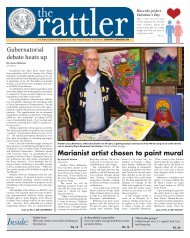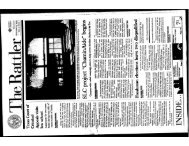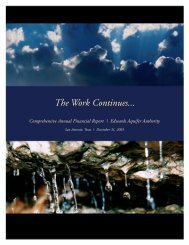The Rattler November 22, 2006 v. 94 #6 - Blume Library - St. Mary's ...
The Rattler November 22, 2006 v. 94 #6 - Blume Library - St. Mary's ...
The Rattler November 22, 2006 v. 94 #6 - Blume Library - St. Mary's ...
- No tags were found...
Create successful ePaper yourself
Turn your PDF publications into a flip-book with our unique Google optimized e-Paper software.
Features<strong>November</strong> <strong>22</strong>, <strong>2006</strong> <strong>The</strong> <strong>Rattler</strong>www.stmarytx.edu/rattler 7By NANCY MARTINEZADVERTISING MANAGERPHOTO BY NANCY MARTINEZSophomore business managementmajor Elaine Greenwood isoften found at Sultan’s Café andGrill on the weekends.<strong>The</strong> lounge-style setting, withcomfortable couches and accentedMiddle Eastern decorations, distinguishesthe popular spot.It is one of about ten “bars” onecan find in San Antonio that offersthe experience of smoking shisha,or flavored tobacco, through a waterpipe called hookah.<strong>The</strong> amount of visitors frequentingone of these loungeson a given Saturday night is aclear indicator of the tradition’sgrowing popularity.“<strong>The</strong> fact is that when I amsmoking it, I am with my friends.It is more a social aspect than anything,”Greenwood said.Junior speech communicationmajor Sonia Charbel and herbrother Danny Charbel, <strong>St</strong>. Mary’salumnus, both have grown upwith this tradition. <strong>The</strong>y agree thatthe social aspect of the tradition isvery important.“It’s a social thing, for when wehave guests at the house for example.Some people go out drinking,and we fix a hookah,” Sonia said.Hookah, or narghile as it iscalled in the Middle East, originatedin India more than 500years ago.<strong>The</strong> hookah contains four parts:the glass base where the water iscontained, the regulator that takesthe smoke from the tobacco, a clayplate to house the tobacco whichis heated with coals and the hosefrom which the person inhales.“It’s definitely a cultural thing,my dad’s dad showed him and heshowed me. As long as I have remembered,there has been one atthe house,” Danny said.<strong>The</strong> hookah has evolved fromcoconut shells to modern glow inthe dark glass but it never loses itsoriginal purpose and design.“I’ve seen some made with twoto six hoses, some swivel, some areplastic, some glass. <strong>The</strong>re is about50-60 flavors from flour to apple tolicorice,” Sonia said.A common misconception ofhookah is that it does not harm thesmoker’s health.<strong>The</strong> American Cancer Society(ACS) and the World Health Organization(WHO) counter that byclaiming that “regardless of form,flavor, or disguise, tobacco is stilla killer.”Despite these health concerns,Greenwood said she considershookah a less-threatening form ofsmoking tobacco.“<strong>The</strong> first time I did it, I got aPHOTO BY LIZ HERRERAAbove: Smoking tobacco througha hookah water pipe is a practicewhich dates back to India morethan 500 years ago. <strong>The</strong> hookahcontains four parts: a glass base,a regulator, a clay plate to hold thetobacco and a hose from which toinhale the flavored smoke.Left: Alumnus Danny Charbel preparesthe tobacco, which is calledshisha, before smoking from thehookah at his home. He said thatsmoking the flavored tobacco ismore of a tradition than a hobby,which his family uses when theyentertain guests.Middle Eastern traditionclouds over the WestHookah lounges grow in popularity, worry health organizations.little light headed but it does notdo the same now. I think it is probablythe lesser evil of all things youcould smoke,” she said.ACS states that the water doesnot filter out many of the toxinssuch as carbon monoxide, nicotineand heavy metals.Attempts to reverse the evergrowingpopularity have alreadybeen enacted in parts of theMiddle East.Several types of cancer, includinglung cancer, have been linkedto hookah smoking.Hookah is also associated withspreading diseases such as tuberculosisthrough the sharing ofthe mouthpiece.Danny acknowleges the dangersthat are associated withhis habit.“Of course, I’m concerned.I’ve been reading the studies thathave been done about the effectsof smoking hookah and I understandthat since it is a very socialthing, the volume you take inmakes it worse than a cigarette,”Danny said.An alternative to smoking inone of these lounges would be totry Middle Eastern food and enjoythe atmosphere.This way, people can socializewithout risking their health.PLAY REVIEWDrama departmentbreaks through CeilingBy JESSICA RODRIGUEZSTAFF WRITERThrough Nov. 10 to Nov. 18, the<strong>St</strong>. Mary’s Department of Dramapresented Arthur Miller’s play,<strong>The</strong> Archbishop’s Ceiling. <strong>The</strong> playcenters on the liberties and thepowerlessness of writers, set inan unidentified European countryduring the 1970s.<strong>The</strong> play follows Americanwriter, Adrian Wallach (Jason J.Casanova), who travels to a Europeancity during the Cold Warin order to restart a novel he hasabandoned. His encounter with adose of Communist society initiatesthe events of the play.After conversing with Maya(Lydia Acosta), the woman whoinspired his novel, Adrian becomesenveloped in the intriguesurrounding the candid novelistSigmund (Rolando Herrera) andthe writer Marcus (Osvaldo Hernandez).<strong>The</strong> five-person cast alsoincludes Irina (Emily Cancellare),a Dane who serves as Marcus’arm candy.<strong>The</strong> main conflict of the play involvesthe government’s stealingof the manuscript Sigmund hasspent the last five years writing.Tension then results from thedecision Sigmund must make toeither stay and write in a countrywhere he is unwanted, beingforced to publish through the undergroundpress, or to flee to anotherless oppressive country.Directed by Patrick Donnelly,visiting instructor of Drama, everythingabout this productionwas outstanding. <strong>The</strong> scenic design,done by Director of <strong>The</strong>atreBernadette Hamilton-Brady,properly conveyed the cold andsurreal atmosphere surroundingCommunist oppression.Donnelly lit the stage with awarm glow, giving it an ominousundertone. More than insinuatingnight and day, the lighting evokeda sense of the uncertainty pervadingthe characters’ lives.Acosta gave a seductive andmysterious performance of Maya,conveying the difficulties of lifeunder the oppression. Similarly,Casanova portrayed Adrianas anxious and restless whileHerrera’s Sigmund was drivenand dynamic.Hernandez gave a suave performanceof Marcus and Cancellare’sportrayal of the lively, jazz-lovingIrina was not only convincing butdelightful as well.According to Hamilton-Brady,the drama department received agood response for auditions.“It is always difficult to choosethe cast. Sometimes the actorsare really talented, but they don’tphysically fit the character. We notonly have to look at the actor, butalso at the dynamics of the entirecast,” Hamilton-Brady said.Acosta, a freshman speechcommunications major, said sheauditioned because of her loveof theater and the Department ofDrama’s good reputation.On her role as Maya, Acostasaid, “I can relate to my characterbecause she tends to be more intelligentthan the men and she lovesto talk.”Senior José Rocha attended theperformance on its opening night.“As an international relationsmajor, I am prone to studyingCommunist countries, especiallyduring the time period in whichthe play was set,” he said. “I believethe representation of theproblems of a Communist nationwas noteworthy and the characterswere able to portray the essenceof the time.”By and large, the production of<strong>The</strong> Archbishop’s Ceiling was onewith contemporary significance.<strong>The</strong> play appeals to not only artlovers and political enthusiasts,but also the general audience.
















